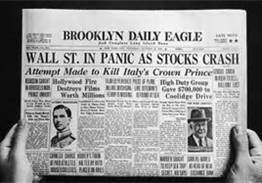What Really Caused the Crash of ’29
 The Stock Market Crash of October 1929 was the largest market collapse in U.S. history. The crash lasted a month and precipitated a general downward economic spiral that led to bank insolvency, business collapse, home foreclosure, and widespread bankruptcy. The recession that followed soon evolved into the Great Depression.
The Stock Market Crash of October 1929 was the largest market collapse in U.S. history. The crash lasted a month and precipitated a general downward economic spiral that led to bank insolvency, business collapse, home foreclosure, and widespread bankruptcy. The recession that followed soon evolved into the Great Depression.
Prelude to the Crash
The decade of the 1920s was generally prosperous. By 1929, the Dow Jones Industrial Average (DJIA) was five times higher than it was in 1923. But after peaking in September 1929 at 381.17, the DJIA fell sharply for a month, leading to Black Thursday on October 24.
The primary reason for the boom-and-bust cycle that took place was the Federal Reserve System. In an effort to provide easy credit for business, the Fed expanded the money supply. While this expansion helped the economic boom, it also enabled many businesses to overextend.
A byproduct of the overextension was overspeculation. The access to easy credit led people to invest heavily in the stock market, and borrowed money was often invested in the hopes of turning a profit that could repay the loans. The more money that was invested, borrowed or otherwise, the higher the prices rose. By August 1929, over $8.5 billion was on loan, which was more than the entire amount of currency circulating in the U.S.
Another byproduct of overextension was overproduction, which created too much supply and not enough demand. Overproduction prompted many businesses to liquidate, which led to the bust that was sure to come.
Black Thursday, Monday, and Tuesday
The first sharp drop in stock market prices occurred on Monday, October 21. Then on “Black Thursday,” October 24, stock prices plunged dramatically, reflecting a sellers’ panic. A record 12.9 million shares were traded as people who bought on margin (i.e., invested with borrowed money) frantically tried to cover their loans. Companies like RCA and Westinghouse lost nearly half their value.
Leading Wall Street bankers met to discuss how to handle the crisis. They designated New York Stock Exchange (NYSE) Vice President Richard Whitney to use the $240 million emergency banker fund to buy blue chip stocks in an effort to restore market confidence. This tactic was similar to what steadied the market during the Panic of 1907, and it succeeded in halting the slide for the day. But more was to come.
October 28 became “Black Monday” when the DJIA lost a record 13 percent of its value as more investors sold or traded their shares. Then October 29 became “Black Tuesday,” the worst single day in NYSE history, as 16.4 million shares were dumped in a selling rush, a record held until 1968.
The DJIA fell another 12 percent as the market lost $14 billion on “Black Tuesday” alone and $30 billion for the week. The stock ticker did not catch up with all the transactions until about 7:45 p.m. Some stocks dropped over 35 points or as much as $60 per share. Prices continued dropping throughout November, and the NYSE was forced to close for three days. The initial panic continued for two weeks, and by the end of November, stocks were at 1927 levels. By December 1, stocks had lost $26 billion in value.
Aftermath
By year’s end, $14 billion had vanished. On July 8, 1932, the DJIA reached its lowest level of the 20th century, which was 89 percent lower than its peak in September 1929. By 1933, prices were 80 percent lower than the highs of 1929.
Many historians blame the stock market crash on the excesses of capitalism by assuming that the boom-and-bust cycle is a natural part of a free market economy. But according to the Austrian economic theory, the boom-and-bust cycle is an unnatural occurrence in a free market economy that is caused by a central bank controlling a nationalized currency, in this case, the Federal Reserve.
In testimony before a Senate committee, 25 million people were affected by this financial catastrophe. The future had been bright for a prosperous America, but now one of the most difficult economic crises in U.S. history had begun.





